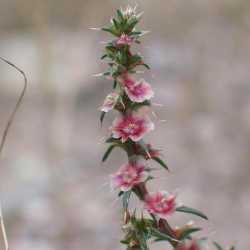Herbs, annual, or subshrubs [shrubs and small trees] , glabrous, or ± pubescent or hispid. Stems erect, ascending, or prostrate, branched (rarely simple), not jointed, not armed, not fleshy. Leaves mostly alternate (rarely opposite, especially proximal ones), sessile; blade lanceolate, linear, or filiform to subulate, semiterete, margins entire basally, apex obtuse, soft and subspinescent or narrowed to spine or soft bristle. Inflorescences spicate, flowers solitary in axils of bracts or reduced distal leaves (rarely 2-3-flowered with lateral flowers poorly developed); bracts ovate-lanceolate, spine-tipped. Flowers bisexual, with 2 bracteoles; perianth segments persistent, 5, covering utricle at maturity, often developing transverse, dorsal, membranous or ± coriaceous wing (sometimes only 2-3 segments winged, sometimes wingless or nearly so); stamens 5; styles and stigmas 2 (or 3). Fruits utricles, covered by perianth segments at maturity; pericarp adherent. Seeds usually horizontal, orbicular; seed coat black or brown; perisperm absent. x = 9.
In this treatment, a rather broad and traditional generic concept is accepted for Salsola, including Caroxylon and other segregate genera. It is evident that Salsola in the traditional sense should be regarded as a group of genera rather than a natural monophyletic genus. V. I. Pyankov et al. (2001) recently discussed phylogenetic relationships inferred from parsimony analysis of nucleotide sequences of the internal transcribed spacer regions (ITS) of the 18S-26S nuclear ribosomal DNA of 34 species of Salsola and related genera (Halothamnus Jaubert & Spach, Climacoptera Botschantzev, Girgensohnia Bunge, Halocharis Moquin-Tandon, and Haloxylon Bunge) and four species from representative outgroups (tribes Camphorosmeae and Atripliceae). The study confirmed that Salsola sensu lato is polyphyletic, with several currently recognized related genera rooted within the group. Results of the V. I. Pyankov et al. study also contradict V. P. Botschantzev´s (1969) hypothesis of a South African origin of Salsola sensu lato and place the 'cradle' of the genus in central Asia. A comparative taxonomic and phytogeographic analysis (S. L. Mosyakin 2002) also suggests the place of origin of the Salsola generic aggregate is somewhere in the Tethyan region of south-central Asia (probably northern coasts of the ancient Tethys, or adjacent inland lacustrine habitats). Almost all North American taxa belong to Salsola sensu stricto. Species of Salsola sect. Caroxylon (Thunberg) Fenzl, which is represented in North America only by the introduced S. vermiculata, may be recognized in the distinct genus Caroxylon Thunberg following a comprehensive study of the group worldwide.
Fls perfect; cal deeply 5-lobed, the segments at maturity incurved over the fr, transversely carinate or winged, the tips connivent and erect; stamens usually 5; styles 2; seed thick, horizontal; embryo spirally coiled; perisperm none; ours branching, annual herbs with linear, succulent, ±spinulose-tipped lvs, the fls solitary or few in the axils of the shorter and spinier upper lvs (bracts), each subtended by a pair of bracteoles. 50+, widespread.
Gleason, Henry A. & Cronquist, Arthur J. 1991. Manual of vascular plants of northeastern United States and adjacent Canada. lxxv + 910 pp.
©The New York Botanical Garden. All rights reserved. Used by permission.






